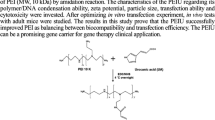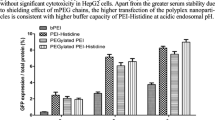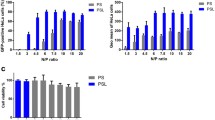Abstract
A novel low cytotoxicity and high efficiency transfection reagent, human serum albumin (HSA)-conjugated polyethylenimine (PEI) was prepared to improve the effect of PEI on gene transfection in this study. Transfecting a cell with DNA is a crucial step for DNA vaccination or gene therapy. PEI, a non-viral vector, is one of the popularly used cationic polymers because of its intensive positive charge that condenses DNA as a nano-sized complex, and attaches on the negative-charged cell membrane, triggering cell endocytosis. In this study, we used a zero-length cross-linkage EDC system to chemically conjugate HSA and PEI, and the size of final synthesized product HSA-conjugated PEI (HSA-PEI) was 14 nm with a positive zeta potential 20.8 mV. We also evaluated the characteristics of HSA-PEI in cells. We chose the A549 cell line as our evaluation model because of its GP-60 receptor. Our results showed that HSA-conjugated PEI was easily applied to form a nano-sized complex with plasmid DNA (pDNA) by simply mixing. The functional ligand, HSA, has a large size, much free PEI (or equivalent free PEI effect) and increases the protection of pDNA by stereo-barring, good condensation effect. HSA-PEI also showed good pDNA transfection enhancement in A549 cell lines, and low toxic characteristics.











Similar content being viewed by others
References
Boeckle S, von Gersdorff K, van der Piepen S, Culmsee C, Wagner E, Ogris M (2004) Purification of polyethylenimine polyplexes highlights the role of free polycations in gene transfer. J Gene Med 6:1102–1111
Boussif O, Lezoualc’ht F, Zanta MA, Mergnyt MD, Schermant D, Demeneixt B, Behr JP (1995) A versatile vector for gene and oligonucleotide transfer into cells in culture and in vivo: polyethylenimine. Proc Natl Acad Sci USA 92:7297–7301
Carrabino S, Gioia SD, Copreni E, Conese M (2005) Serum albumin enhances polyethylenimine-mediated gene delivery to human respiratory epithelial cells. J Gene Med 7:1555–1564
Cheng H, Zhu JL, Zeng X, Jing Y, Zhang XZ, Zhuo RX (2009) Targeted gene delivery mediated by folate–polyethylenimine-block-poly(ethylene glycol) with receptor selectivity. Bioconjug Chem 20:481–487
Chiu SJ, Ueno NT, Lee RJ (2004) Tumor-targeted gene delivery via anti-HER2 antibody (trastuzumab, Herceptin®) conjugated polyethylenimine. J Control Release 97:357–369
Cho YW, Kim JD, Park K (2003) Polycation gene delivery systems: escape from endosomes to cytosol. J Pharm Pharmacol 55:721–734
Deng R, Yue Y, Jin F, Chen Y, Kung HF, Lin MCM, Wu C (2009) Revisit the complexation of PEI and DNA—how to make low cytotoxic and highly efficient PEI gene transfection non-viral vectors with a controllable chain length and structure. J Control Release 140:40–46
Dey D, Inayathullah M, Lee AS, LeMieux MC, Zhang X, Wu Y, Nag D, De Alemeida PE, Han L, Rajadas J, Wu JC (2011) Efficient gene delivery of primary human cells using peptide linked polyethylenimine polymer hybrid. Biomaterials 32:4647–4658
Diaz-Moscoso A, Vercuteren D, Rejman J, Benito JM, Mellet CO, De Smedt SC, Fernández JMG (2010) Insights in cellular uptake mechanisms of DNA–polycationic amphiphilic cyclodextrin nanoparticles (CDplexes). J Control Release 143:318–325
Djurovic S, Iversen V, Jeansson S, Hoover F, Christensen G (2004) Comparison of nonviral transfection and adeno-associated viral transduction on cardiomyocytes. Mol Biotechnol 28:21–32
Dokka S, Malanga CJ, Shi X, Chen F, Castranova V, Rojanasakul Y (2000) Inhibition of endotoxin-induced lung inflammation by interleukin-10 gene transfer in mice. Am J Physiol Lung Cell Mol Physiol 279:L872–L877
Hanzlíková M, Ruponen M, Galli E, Raasmaja A, Aseyev V, Tenhu H, Urtti A, Yliperttula M (2011) Mechanisms of polyethylenimine-mediated DNA delivery; free carrier helps to overcome the barrier of cell-surface glycosaminoglycans. J Gene Med 13:402–409
Hunter AC (2006) Molecular hurdles in polyfectin design and mechanistic background to polycation induced cytotoxicity. Adv Drug Deliv Rev 58:1523–1531
Intra J, Salem AK (2008) Characterization of the transgene expression generated by branched and linear polyethylenimine–plasmid DNA nanoparticles in vitro and after intraperitoneal injection in vivo. J Control Release 130:129–138
Jeon O, Yang HS, Lee TJ, Kim BS (2008) Heparin-conjugated polyethylenimine for gene delivery. J Control Release 132:236–242
John TA, Vogel SM, Minshall RD, Ridge K, Tiruppathi C, Malik AB (2001) Evidence for the role of alveolar epithelial gp60 in active transalveolar albumin transport in the rat lung. J Physiol 533(Pt2):547–559
Kafil V, Omidi Y (2011) Cytotoxic impacts of linear and branched polyethylenimine nanostructures in A431 cells. BioImpacts 1:23–30
Khosravi-Far R, Zaker Z, Lockshin RA, Piacentini M (2008) Transfection reagent. In: Method in enzymology. Vol 446: programmed cell death (part B). Elsevier, Inc., Amsterdam, p 146
Kim KJ, Matsukawa Y, Yamahara H, Kalra VK, Lee VHL, Crandall ED (2003) Absorption of intact albumin across rat alveolar epithelial cell monolayers. Am J Physiol Lung Cell Mol Physiol 284:L458–L465
Ko YT, Kale A, Hartner WC, Papahadjopoulos-Sternberg B, Torchilin VP (2009) Self-assembling micelle-like nanoparticles based on phospholipid–polyethylenimine conjugates for systemic gene delivery. J Control Release 133:132–138
Li D, Yu H, Huang H, Shen F, Wu X, Li J, Wang J, Cao X, Wang Q, Tang G (2007) FGF receptor-mediated gene delivery using ligands coupled to polyethylenimine. J Biomater Appl 22:163–180
Moghimi SM, Symonds P, Murray C, Hunter C, Debska G, Szewczyk A (2005) A two-stage poly(ethylenimine)-mediated cytotoxicity: implications for gene transfer/therapy. Mol Ther 11:990–995
Ogris M, Steinlein P, Sursa M, Mechtler K, Kircheis R, Wagner E (1998) The size of DNA/transferrin–PEI complexes is an important factor for gene expression in cultured cells. Gene Ther 5:1425–1433
Rhaese S, von Briesen H, Rübsamen-Waigmann H, Kreuter J, Langer K (2003) Human serum albumin–polyethylenimine nanoparticles for gene delivery. J Control Release 92:199–208
Saito Y, Higuchi Y, Kawakami S, Yamashita F, Hashida M (2009) Immunostimulatory characteristics induced by linear polyethyleneimine–plasmid DNA complexes in cultured macrophage. Hum Gene Ther 20:137–145
Son S, Kim WJ (2010) Biodegradable nanoparticles modified by branched polyethylenimine for plasmid DNA delivery. Biomaterials 31:133–143
Tousignant JD, Gates AL, Ingram LA, Johnson CL, Nietupski JB, Cheng SH, Eastman SJ, Scheule RK (2000) Comprehensive analysis of the acute toxicities induced by system administration of cationic lipid:plasmid DNA complexes in mice. Hum Gene Ther 11:2493–2513
Veiseh O, Kievit FM, Gunn JW, Ratner BD, Zhang M (2009) A ligand-mediated nanovector for targeted gene delivery and transfection in cancer cells. Biomaterials 30:649–657
Yu JH, Quan JS, Huang J, Nah JW, Cho CS (2009) Degradable poly(amino ester) based on poly(ethylene glycol) dimethacrylate and polyethylenimine as a gene carrier: molecular weight of PEI affects transfection efficiency. J Mater Sci Mater Med 20:2501–2510
Acknowledgments
This study was supported in part by Grants from Department of National Defense (DOD-100-C-04-04) and Institute of Preventive Medicine (IPM-101-B12-2) in Taiwan.
Conflict of interest
The authors declare that there are no conflict of interest.
Author information
Authors and Affiliations
Corresponding author
Rights and permissions
About this article
Cite this article
Chen, JL., Peng, SW., Ko, WH. et al. An efficient and low toxic human serum albumin conjugated polyethylenimine nano-sized complex for gene delivery. J Nanopart Res 16, 2593 (2014). https://doi.org/10.1007/s11051-014-2593-x
Received:
Accepted:
Published:
DOI: https://doi.org/10.1007/s11051-014-2593-x




